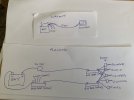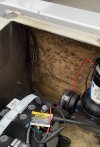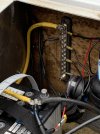Baxter
Well-Known Member
I realize with 12V systems there are a million different ways to do things, more than one right answer. But I want to ask a question, and get some advice on how you guys have your boats wired, specifically when it comes to accessories.
I have posted a pic below, apologies if it is confusing
Current Situation
There is a hard wired 10ga wire going direct from the battery into the sounder, bypassing the switch etc. There is an inline fuse.
In addition, all negative leads from all the stuff tie directly to the one battery. Sure it works, but it is a mess and I don't like it. I want to clean this up with a busbar.
(If it matters, the boat currently had dual 12v batteries. The kicker charges as well as the main. There is a 1/2/1+2/off switch that almost everything goes through with the exception of the Lowrance and the Bilge)
Planned
I want to run the sounder through the switch (no idea why last owner didn't do this, everything else on the boat goes through the switch). To do this though, I need to replace the 10ga wire that is currently run as it is too short to reach the switch. I figure, while I am at it, I will upgrade the gauge of the wire to accommodate future add-ons.
Planned additions include a compass, interior lighting (probably just led strips, but unsure), and a stereo (basic marine grade car-type stereo, nothing fancy, no amp or anthing).
Question 1: is 10 gauge likely enough? Should I go 8? or other?
Plan:
- Add a bus bar at the rear of the boat for all the negative leads (bilge, washdown, motors, etc).
- Add a pair of bus bars at the front of the boat, one for positives, one for negatives for all the stuff up there (sounder, radio, vhf, compass, sounder, etc).
- Replace power cable with higher gauge (if a good idea)
Question: Does this plan (also see pic) make sense? Is this a good idea? better idea out there? (I have thought of adding a fuse panel instead of the positive bus bar - not 100% certain YET on how all that connects, but I know I can figure it out if it is really the best way to go.
That is the gist of it. I have an electrician friend who is happy to help me with this stuff, and I plan to run whatever I come up with past him before going for it, but really wanted to get the opinions and ideas from other boaters who may have a similar situation. Of course I am also about to scour YouTube for ideas also, so telling me to just reference YouTube is pointless
(Edit: In my "current" drawing below, there is an inline fuse for the sounder, so no need to call me out on that, just forgot to draw it )
)

I have posted a pic below, apologies if it is confusing
Current Situation
There is a hard wired 10ga wire going direct from the battery into the sounder, bypassing the switch etc. There is an inline fuse.
In addition, all negative leads from all the stuff tie directly to the one battery. Sure it works, but it is a mess and I don't like it. I want to clean this up with a busbar.
(If it matters, the boat currently had dual 12v batteries. The kicker charges as well as the main. There is a 1/2/1+2/off switch that almost everything goes through with the exception of the Lowrance and the Bilge)
Planned
I want to run the sounder through the switch (no idea why last owner didn't do this, everything else on the boat goes through the switch). To do this though, I need to replace the 10ga wire that is currently run as it is too short to reach the switch. I figure, while I am at it, I will upgrade the gauge of the wire to accommodate future add-ons.
Planned additions include a compass, interior lighting (probably just led strips, but unsure), and a stereo (basic marine grade car-type stereo, nothing fancy, no amp or anthing).
Question 1: is 10 gauge likely enough? Should I go 8? or other?
Plan:
- Add a bus bar at the rear of the boat for all the negative leads (bilge, washdown, motors, etc).
- Add a pair of bus bars at the front of the boat, one for positives, one for negatives for all the stuff up there (sounder, radio, vhf, compass, sounder, etc).
- Replace power cable with higher gauge (if a good idea)
Question: Does this plan (also see pic) make sense? Is this a good idea? better idea out there? (I have thought of adding a fuse panel instead of the positive bus bar - not 100% certain YET on how all that connects, but I know I can figure it out if it is really the best way to go.
That is the gist of it. I have an electrician friend who is happy to help me with this stuff, and I plan to run whatever I come up with past him before going for it, but really wanted to get the opinions and ideas from other boaters who may have a similar situation. Of course I am also about to scour YouTube for ideas also, so telling me to just reference YouTube is pointless
(Edit: In my "current" drawing below, there is an inline fuse for the sounder, so no need to call me out on that, just forgot to draw it

Last edited:




